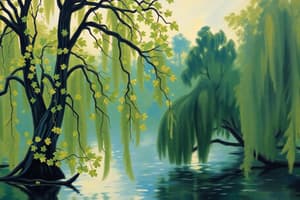Podcast
Questions and Answers
Medium in art exclusively refers to auditory arts.
Medium in art exclusively refers to auditory arts.
False (B)
The technique of an artist does not vary even if they use the same medium.
The technique of an artist does not vary even if they use the same medium.
False (B)
Combined arts are those mediums that can be experienced both visually and audibly.
Combined arts are those mediums that can be experienced both visually and audibly.
True (A)
Watercolor is an easy medium to handle, allowing for warm and rich tones.
Watercolor is an easy medium to handle, allowing for warm and rich tones.
Different mediums used in painting can greatly affect the finished product.
Different mediums used in painting can greatly affect the finished product.
Flashcards are hidden until you start studying
Study Notes
Medium in Art
- Definition: Medium refers to the means artists use to communicate their ideas.
- Categories:
- Visual Arts: Mediums that can be seen and occupy space.
- Auditory Arts: Mediums that can be heard and are expressed in time.
- Subcategories:
- Dimensional: Flat or two-dimensional artworks.
- Three-dimensional: Sculptures and installations that occupy space.
- Combined Arts: Mediums that can be both seen and heard, existing in both space and time.
Technique in Art
- Definition: Technique is how an artist controls their medium to achieve a desired outcome.
- Individuality of Technique: Artists express their unique perspectives and visions, resulting in different techniques even when using the same medium.
- Medium Selection: Artists choose their medium based on their belief that it best conveys their intended message.
Painting Techniques and Mediums
- Meaningful Effects: Artists create impactful visuals on flat surfaces using various pigments.
- Impact of Medium: Each painting medium significantly affects the final product, offering varied treatments and distinct brush strokes.
- Application Surfaces: Mediums can be applied to wet plaster, canvas, wood, or paper.
Watercolor Specifics
- Challenges: Handling watercolor can be difficult due to challenges in producing warmer, richer tones.
- Brilliance and Variety: Watercolor pigments encourage vibrant color and a spectrum of hues.
- Spontaneity: The essence of watercolor lies in its simple and clear spontaneity, allowing for changes even after application.
- Methodology: Painting with watercolor involves applying colors ground in a water or limewater mixture onto a moist plaster surface.
Studying That Suits You
Use AI to generate personalized quizzes and flashcards to suit your learning preferences.




